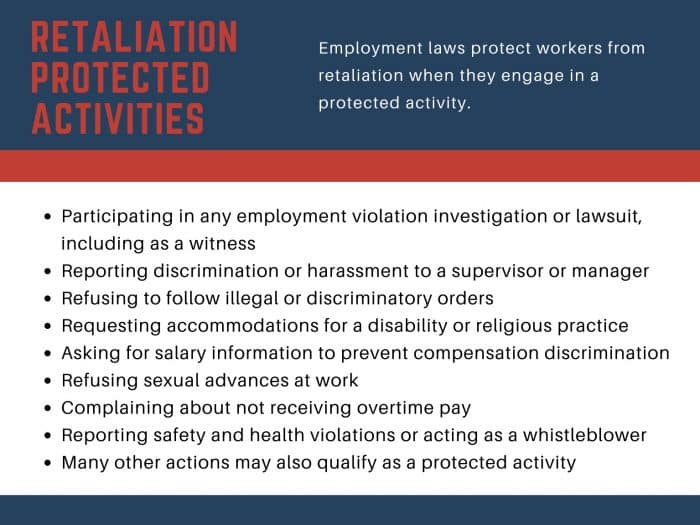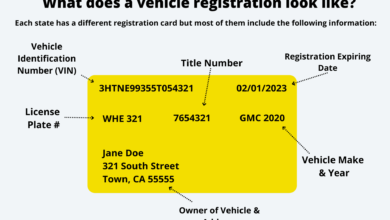What Makes a Strong Retaliation Case: Winning Strategies

A strong retaliation case requires solid evidence to support your claim and prove causation. It hinges on substantiating facts and evidence to strengthen your case.
When facing retaliation in the workplace, building a strong case is crucial for seeking justice and protecting your rights. Adverse actions such as termination or demotion must be linked directly to protected activities. By documenting instances of harassment, discrimination, and reporting these to HR, individuals can establish a clear pattern of retaliation.
This proactive approach can help in proving the adverse employment actions were a direct response to protected activities. Understanding the key factors in a strong retaliation case empowers individuals to navigate legal challenges and seek recourse for unjust treatment.
Introduction To Retaliation Claims
When it comes to workplace dynamics, employees have the right to speak up against discrimination, harassment, or other unlawful practices without fear of retaliation. Understanding the elements that constitute a strong retaliation case is crucial for employees seeking justice. In this guide, we will delve into the essentials of retaliation claims, defining retaliation in the workplace, and the importance of building a strong case.
Defining Retaliation In The Workplace
Retaliation in the workplace occurs when an employer takes adverse action against an employee for engaging in protected activity, such as reporting discrimination, participating in an investigation, or opposing unlawful practices. Adverse actions can include termination, demotion, reduction in pay, or other negative consequences. To establish a retaliation claim, employees must prove that the adverse action was a direct result of their protected activity.
Importance Of A Strong Case
A strong retaliation case is built on compelling evidence and a clear causal connection between the protected activity and the adverse action. The burden of proof for retaliation requires employees to substantiate their claim with facts and evidence, demonstrating that the employer’s actions were retaliatory in nature. Without strong evidence, winning a retaliation case can be daunting, making it essential for employees to gather and document relevant information to support their claim.
Elements Of A Retaliation Claim
To build a strong retaliation case, one must establish protected activity, adverse action, and a causal connection. It’s crucial to gather evidence supporting the claim, like documenting unfair treatment or negative evaluations. Winning a retaliation lawsuit hinges on the strength of the evidence presented.
If you’ve experienced retaliation in the workplace, it’s important to understand the three essential elements of a retaliation claim: protected activity, adverse action, and causal connection. These elements are crucial to building a strong case against your employer. Let’s take a closer look at each one.
Protected Activity
Protected activity refers to any action you take that is protected by law. This includes reporting discrimination or harassment, filing a complaint with HR, participating in an investigation, or refusing to engage in illegal activity. In order to have a strong retaliation claim, you must be able to show that you engaged in a protected activity.
Adverse Action
Adverse action refers to any negative employment action taken against you by your employer. This can include termination, demotion, reduction in pay, or other negative consequences. In order for an employee to have a strong retaliation case, they must be able to prove that the adverse action was a direct result of their protected activity.
Causal Connection
Causal connection refers to the link between the protected activity and the adverse action. In other words, you must be able to show that your employer took the adverse action because of your protected activity. This can be difficult to prove, but it’s essential to building a strong retaliation case.
To summarize, a strong retaliation case involves engaging in a protected activity, experiencing an adverse action, and being able to prove the causal connection between the two. If you believe you’ve experienced retaliation in the workplace, it’s important to seek legal counsel and gather evidence to support your claim. Remember, your case is only as strong as the evidence you have.
Gathering Evidence
Strong evidence is crucial in building a successful retaliation case. Without concrete proof, your claim may not hold up in court. Gathering evidence is a critical step in establishing the validity of your case.
Documenting Unfair Treatment
Documenting instances of unfair treatment is essential. Keep a detailed record of any discriminatory actions, such as emails, memos, performance reviews, or reprimands. This documentation serves as tangible evidence to support your claims.
Collecting Emails And Statements
Collect all relevant emails and statements that demonstrate retaliation. These communications can provide insight into the motives behind the adverse actions taken against you. Having a paper trail can strengthen your case.
Witness Testimonies
Obtaining witness testimonies from colleagues who have observed the mistreatment can bolster your case. Their firsthand accounts can corroborate your claims and provide additional credibility to your allegations.
Legal Standards And Burden Of Proof
When it comes to building a strong retaliation case, understanding the legal standards and burden of proof is crucial. This involves demonstrating that the adverse action taken by the employer was directly linked to the employee’s protected activity. Both federal and state laws provide guidelines for proving this link and establishing a solid retaliation case.
Federal And State Laws
Under federal law, retaliation claims are protected by statutes such as Title VII of the Civil Rights Act of 1964, the Age Discrimination in Employment Act, and the Americans with Disabilities Act. Similarly, many states have their own anti-retaliation laws that provide additional protections for employees.
Proving The Link To Protected Activity
Proving the link to protected activity involves demonstrating that the adverse action was a direct result of the employee engaging in activities protected by law, such as reporting discrimination or harassment, participating in investigations, or exercising other legally protected rights within the workplace.
Common Challenges In Retaliation Cases
Retaliation cases can be fraught with challenges that can make it difficult for employees to prove their claims. Understanding and addressing these common challenges is crucial in building a strong retaliation case.
Disproving Employer’s Legitimate Reasons
One of the primary challenges in a retaliation case is disproving the employer’s legitimate reasons for any adverse actions taken against the employee. Employers often try to justify their actions by citing performance issues or other valid reasons. Disproving these legitimate reasons requires thorough documentation and evidence to demonstrate that the adverse action was a direct result of the employee’s protected activity.
Dealing With Complex Evidence
Retaliation cases often involve complex evidence, including emails, performance reviews, witness statements, and other documentation. Dealing with this complex evidence can be challenging, especially when it comes to establishing a clear causal connection between the protected activity and the adverse action. It requires meticulous analysis and presentation of evidence to establish a strong correlation.

Credit: www.trinet.com
Strategies To Strengthen Your Case
When building a strong retaliation case, there are key strategies that can significantly enhance your chances of a successful outcome. By implementing these strategies effectively, you can bolster your case and demonstrate the validity of your claims.
Timely Reporting Of Incidents
- Report incidents promptly to establish a clear timeline of events.
- Ensure documentation includes dates, times, and details of each incident.
Maintaining Detailed Records
- Keep thorough records of all communications and interactions related to the retaliation.
- Document any retaliatory actions taken by the employer with as much detail as possible.
Seeking Legal Advice Early
- Consult with an experienced employment attorney as soon as possible.
- Obtain guidance on the legal aspects of your case and how to proceed effectively.
Case Studies And Precedents
To build a strong retaliation case, it is crucial to have substantial evidence supporting your claim. This evidence should demonstrate the causal connection between the protected activity and the adverse action. Key factors in a strong retaliation case include detailed documentation of unfair treatment and negative evaluations.
Successful Retaliation Claims
When it comes to retaliation claims, success is often determined by the strength of the evidence. One key factor that can make a retaliation case strong is the ability to prove that the adverse action taken by the employer was a direct result of the employee’s protected activity. This can include actions such as termination, demotion, or reduction in pay.
In successful retaliation claims, employees are typically able to provide clear evidence of the connection between their protected activity and the adverse action taken by their employer. This can include documentation of conversations with managers or HR, emails or memos related to the protected activity, or witness statements from colleagues who observed the adverse action.
Lessons Learned From Failed Cases
While successful retaliation claims can provide valuable precedent for future cases, it’s also important to learn from cases that did not succeed. In failed retaliation cases, the evidence was often not strong enough to prove a direct connection between the protected activity and the adverse action taken by the employer.
In some cases, employees may have waited too long to report the retaliation, making it more difficult to establish a causal connection. In other cases, employees may not have documented their protected activity or the adverse action taken by their employer.
Looking at case studies and precedents can be helpful in understanding what makes a strong retaliation case. For example, in the case of Burlington Northern & Santa Fe Railway Co. v. White, the Supreme Court ruled that adverse actions can include actions that do not involve a tangible employment action, such as a demotion or reduction in pay. This ruling expanded the definition of retaliation and provided important precedent for future cases.
Additionally, the case of Crawford v. Metropolitan Government of Nashville and Davidson County established that employees are protected from retaliation even if they were not the original complainant in a discrimination case. This precedent can be helpful for employees who may have been retaliated against for providing support or testimony in someone else’s discrimination case.
Overall, case studies and precedents can provide valuable insight into what makes a strong retaliation case. By understanding the key factors that have led to successful claims in the past, employees and their legal teams can build stronger cases and increase their chances of success.

Credit: mrjustice.com
Conclusion And Next Steps
To build a robust retaliation case, gather solid evidence linking adverse actions to protected activities. Documentation is key in substantiating your claim and proving the causal connection required for a successful case. The strength of your evidence determines the outcome of your retaliation claim.
Assessing Your Case’s Strength
When considering a retaliation case, it’s crucial to assess the strength of your evidence. Your case’s strength hinges on the evidence you can provide to substantiate your claim. This may include documentation, witness statements, and other tangible proof of the retaliatory actions.
Additionally, evaluating the severity of the adverse action and its direct correlation to the protected activity is imperative. The stronger the connection between the adverse action and the protected activity, the more robust your case becomes.
When To Consider Legal Action
It’s essential to consider legal action when you have substantial evidence to support your retaliation claim. If you’ve experienced adverse actions such as termination, demotion, or pay reduction due to engaging in protected activities, it may be time to seek legal recourse.
Moreover, if your employer’s actions would deter a reasonable person from opposing discrimination or harassment, it’s a strong indication that legal action may be warranted.

Credit: www.workingnowandthen.com
Frequently Asked Questions
How Hard Is It To Win A Retaliation Lawsuit?
Winning a retaliation lawsuit can be challenging, but strong evidence can lead to success. It’s crucial to substantiate your claim with facts and evidence to strengthen your case.
What Is The Burden Of Proof For Retaliation?
The burden of proof for retaliation requires strong evidence to substantiate your claim.
What Are The Three Elements Of A Retaliation Claim?
To prove a retaliation claim, you need: protected activity, adverse action, and causal connection as essential elements.
How Do You Prove Your Boss Is Retaliating Against You?
To prove your boss is retaliating against you, document instances of harassment or discrimination. Report the behavior to HR and gather evidence of any adverse actions taken against you. This evidence will be crucial in substantiating your claim.
Conclusion
A strong retaliation case hinges on solid evidence and factual substantiation. The key lies in demonstrating the direct correlation between the adverse action and the protected activity. Documenting every detail is crucial to building a compelling case. With thorough documentation and strong evidence, winning a retaliation lawsuit is indeed possible.




